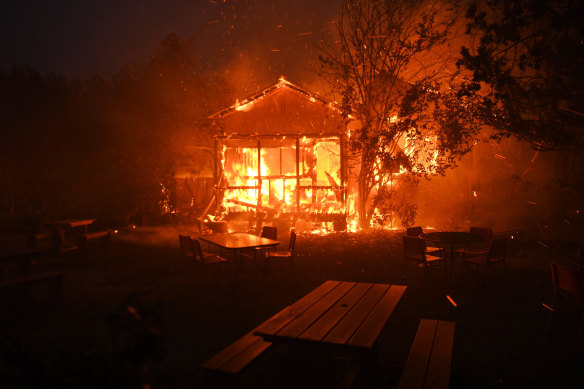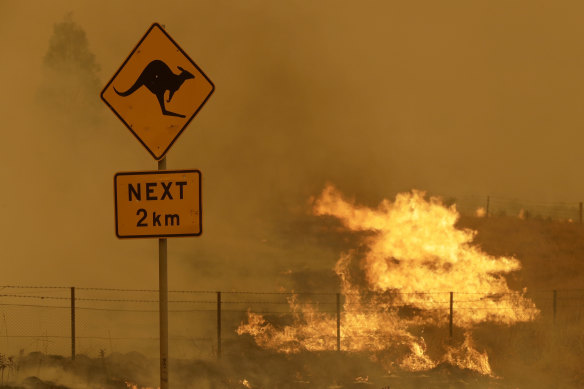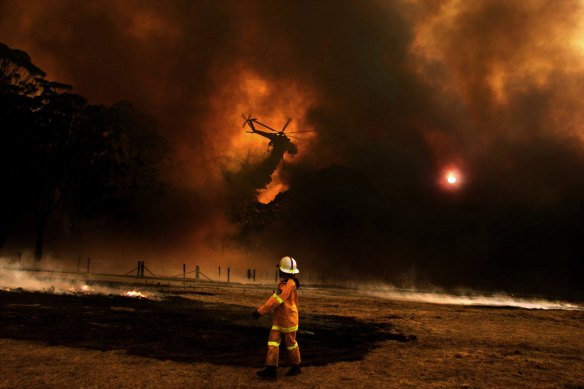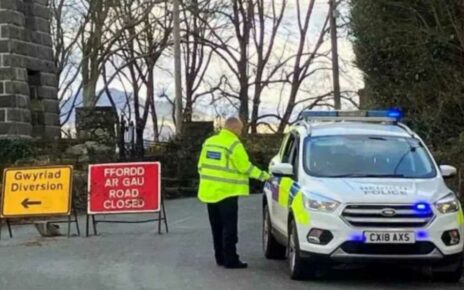Save articles for later
Add articles to your saved list and come back to them any time.
Fire authorities have urged residents of NSW to prepare for a bad bushfire season, particularly as the onset of an El Niño promises higher heat and drier conditions during spring and summer that could exacerbate dangerous fire weather.
The NSW Rural Fire Service recommends these steps to help protect lives and homes this fire season.
The 2019-20 bushfires killed 26 people, destroyed 2476 homes and burnt 5.5 million hectares of the state.Credit: Nick Moir
Know your risk
People living in homes surrounded by bushland or adjacent to grassland and paddocks are at risk of bushfire, even if you live a few streets back from scrub or grassland.
There’s an increased risk of grass fires this summer after growth spurred by three years of La Niña rain begins to dry out. Grassland covers 80 per cent of the state, according to the RFS.
Grass fires are unpredictable and move triple the speed of bushfires. They generate deadly heat and can catch people off guard due to their speed.
Grassfires are fast, hot and unpredictable.Credit: AP
People living on the coast are also at risk from coastal heath and scrub, which can burn quickly.
You can check if you’re in a bushfire prone area by entering your address in this RFS tool, or find a Bush Fire Prone Land Map on your local council’s website.
You don’t need to live close to vegetation to be affected by bushfire. Wind can pick up burning leaves, fine bark and twigs and propel embers up to 30 kilometres ahead of a fire front.
The vast majority of houses destroyed during bushfires ignite from these ember attacks.
How to prepare for a bushfire
If you live in an area close to bush or grassland, you should prepare a bushfire survival plan.
Four steps to prepare a Bushfire Survival Plan
You should discuss with your household whether you’ll leave early or decide to stay when a bushfire approaches your home.
If you decide you’ll leave early, which the RFS says is the safest option, know when you’ll decide to leave, where you’ll go, how you’ll get there, what you’ll take and who you’ll notify that you’re leaving and have arrived safely.
The ‘Elvis’ water-bombing helicopter dumps water on fires near Braemar during the 2019-20 bushfire season.Credit: Nick Moir
It’s not safe to stay if the fire danger is catastrophic. If the fire rating is extreme, it’s not safe to stay unless your house is designed to withstand bushfires.
If you decide to stay, consider whether anyone in the house will be at risk under hot and smoky conditions, ensure your house is prepared, and you have all the equipment necessary to stay safe.
The RFS recommends:
- A hose or hoses that can reach all around the house
- Water supply of at least 10,000 litres, (for example a water tank, dam or pool)
- A petrol or diesel water pump and fuel in a safe, accessible place
- Ladders to access inside the roof
- Buckets and mops
- Shovels and metal rakes
- Protective clothing including a wide-brimmed hat, eye protection goggles, a moistened face mask or cloth, gloves, long cotton pants or jeans, a loose long-sleeved cotton shirt and sturdy leather shoes or boots
Ahead of bushfire season you should clear your gutters, keep lawns short and clear up fallen leaves, twigs and debris around the property. Check the full list of what you should do to prepare your property and use the bushfire household assessment tool on the RFS website for more information.
Top five actions to make your home safer ahead of time
What to do during a bushfire
If there’s a risk of a bushfire approaching your home, before the fire arrives you should:
- Close windows, doors and vents
- Fill baths, sinks, buckets and bins with water
- Confine pets to one room
- Place a ladder next to a roof access hole, so you can check for spot fires
- Soak towels and rugs and lay them across external doorways
- Move furniture away from windows
- Turn off gas mains and/or bottles
- Move flammable items away from the house
- Block drain pipes with socks full of sand and fill gutters with water
- Move animals to a well-grazed or ploughed area away from the house and wind
- Start patrolling the house and put out embers and spot fires
- Wet the side of the house and garden that faces the fire
- Move firefighting equipment inside where it won’t burn
If the fire is upon you or the heat becomes unbearable, the RFS says to shelter inside until the fire front has passed, which usually takes between 5 and 10 minutes. Shelter in a room farthest from the fire front and ensure there’s an exit.
Patrol the inside of the house to douse spot fires and embers.
After the fire front passes, check your home and surrounds for spot fires, including the roof cavity, under the house, decks, stairs and windowsills. Continue patrolling for several hours. When safe to do so, check on neighbours and let relatives or friends know you’re safe.
The RFS’s full guide to creating a Bushfire Survival Plan is available here.
Start the day with a summary of the day’s most important and interesting stories, analysis and insights. Sign up for our Morning Edition newsletter.
Most Viewed in National
From our partners
Source: Read Full Article





